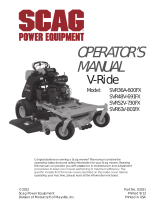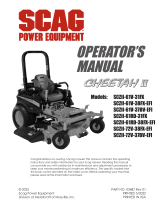
5
Section 2
2.4 TESTING THE SAFETY INTERLOCK
SYSTEM
The safety interlock system should be tested each time
before using the machine. If the safety interlock system
does not operate as described below, contact your local
Authorized Scag Power Equipment Dealer immediately to
have the safety interlock system repaired.
-NOTE-
The machine will not start with the operator off
of the platform. For all test procedures listed
below, the engine must be started with the
operator standing on the platform unless specified
otherwise.
1. Place the spreader switch to the OFF (down)
position, release the parking brake. Stand on the
operator platform in the operating position. Try to
start the engine; the engine should not start.
2. Place the steering control levers in the neutral
position, engage the parking brake, move the
spreader switch to the OFF (down) position, and
start the engine. Stand on the operator platform
in the operating position with the engine running,
engage the spreader switch to the ON (up) position,
and step backwards off of the operating platform.
The spreader should shut off and the engine should
stay running.
3. Stand on the operator platform in the operating
position, place the steering control levers in the
neutral position, engage the parking brake, move
the spreader switch to the OFF (down) position, and
start the engine. With the engine running, release
the parking brake, and step backwards off of the
operating platform. The engine should shut off.
4. Stand on the operator platform in the operating
position, place the steering control levers in the
neutral position, engage the parking brake, move
the sprayer switch to the OFF (down) position, and
start the engine. With the engine running, move
the sprayer switch to the ON (up) position, release
the parking brake, and step backwards off of the
operating platform. The engine should shut off and
the sprayer pump should stay running.
5. Stand on the operator platform in the operating
position, place the steering control levers in the
neutral position, engage the parking brake, move
the sprayer switch to the OFF (down) position, and
start the engine. With the engine running, move the
sprayer switch to the ON (up) position, and step
backwards off of the operating platform. The engine
and sprayer pump should stay running.
2.5 OPERATION CONSIDERATIONS
1. Know the function of all controls and how to stop
quickly.
WARNING
DO NOT operate on steep slopes. Under no
circumstances should the machine be operated
on slopes greater than 15 degrees. See Figure 2-3,
Page 11 to determine approximate slope of area to
be sprayed. ALWAYS FOLLOW OSHA APPROVED
OPERATION.
2. Reduce speed and exercise extreme caution on
slopes and in sharp turns to prevent tipping or loss
of control. Be especially cautious when changing
directions on slopes.
3. Stay two machine widths away from slopes, drop
offs, ditches, water, retaining walls avoid any slope
exceeding 15-degrees.
4. To prevent tipping or loss of control, start and stop
smoothly, avoid unnecessary turns and travel at
reduced speed.
5. Immediately apply the parking brake if you lose
steering control while operating. Inspect the machine
and correct the problem before continuing to operate.
6. When using any attachment, never direct the
chemical and/or material toward bystanders or allow
anyone near the machine while in operation.
7. Start the engine with the operator in the operating
position, the sprayer/spreader disengaged, parking
brake is engaged, and the neutral lever is in neutral.
8. If the machine sprayer/spreader system ever plugs,
shut off the engine, remove the ignition key, and
wait for all movement to stop before removing any
obstructions. (use proper personnel protective
equipment (PPE) while working with any chemicals.)


































